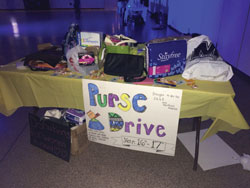Monmouth’s Urban Coast Institute’s (UCI) hosted its latest installment in its return to the Marine and Environmental Lecture Series on Tuesday, Jan. 26. The discussion was advertised as, A Tale of Two Seal Hunts: Contesting the Conflation of Canadian Sealing Activities.
Consistent with previous lectures, the online forum was moderated by Randall Abate, Professor in the Department of Political Science and Sociology, the Rechnitz Family/UCI Endowed Chair of the Urban Coast Institute, and Director of the Institute for Global Understanding (IGU). Tony MacDonald, Director of the Urban Coast Institute, was also in attendance.
Abate introduced the meeting’s agenda, marking the return of the UCI’s Marine and Environmental Law Lecture Series. He referred those seeking additional information about the Institute to its website, which he called, “an ocean and environmental law geek’s dream.” Abate then introduced the UCI’s guest lecturer, Ph.D. Candidate at the University of Oxford Faculty of Law, Sarah Levy. Her recent work has earned her publication in the Journal of International Wildlife Law and Policy.
The foundation of the discussion was centered around the two types of seal hunts that occur in Canada— “one being the Inuit seal hunt, occurring in the Arctic, and the second being the commercial seal hunt, which takes place on the Atlantic side of Canada,” began Levy. The conflation of the two seal hunts is due largely to both deliberate and unintentional misinformation by the commercial industry, the government, and interest groups. These misconceptions have enabled unwarranted biases toward the native Inuit population, whose livelihood suffers as a consequence, she explained.
Levy then explained the Inuit method of hunting, “The Inuit’s method of sealing is individualized. Basically, the hunt occurs so that one seal is hunted at a time, with the hunter stalking and waiting for the seal to come up through a hole in the ice.” Levy elaborated on how the Inuit people harvest the seals in a variety of ways, using their meat and fur to sell in the commercial market and pay for other man-made resources, like fuel and ammunition. However, the most critical point in this discussion was the emphasis on how Inuit hunters are trained to mitigate the suffering of their prey. “The Inuit method of hunting has been found by veterinarians in several studies to be humane,” said Levy.
This is largely different from how commercial sealers go about harvesting, failing to kill in one blow, Levy explained. She continued, “These hunters follow a three-step process, that is, strike, check, and bleed.” Currently, the commercial industry runs at a loss due to ban by the European Union (EU) on seal fur products. This ban applies to the pelts sold by the Inuit, who face both social and economic losses as a result of these commercial-related repercussions.
In the closing Q&A session, Levy made note of how people can simplify what appears to be an overly complex situation. “There is hope that groups have made it their mandate to dispel this conflation by bringing about change through really successful public awareness campaign,” she said.




